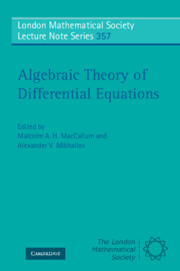Book contents
4 - Introduction to D-modules
Published online by Cambridge University Press: 03 May 2010
Summary
The history of D-module theory starts in 1960-70s and is connected with the names of Mikio Sato and Joseph Bernstein. Many well-known mathematicians, such as Kashiwara and Malgrange, contributed to the area over the years. There is a long list of options for reading on the subject, from which one can choose according to one's liking and background. A rather elementary text [8] needs no deep knowledge of algebraic geometry, deeper treatments can be found in [5, 6, 14], more specialized introductions are provided by chapters of [24] (applications to hypergeometric equations) and [12] (computation of local cohomology modules).
What we intend to provide here is a short primer covering the basics of the algorithmic D-module theory. The D-modules are defined as left modules over an algebra D of linear differential operators with either polynomial coefficients or coefficients in the field of rational functions.
There are three parts: the first introduces the Weyl algebra and discusses its basic properties, the second is devoted to a “nice” subcategory of the category of D-modules, the holonomic D-modules, the third features applications of the theory and its algorithmic aspects to hyper-geometric differential equations and local cohomology.
In what follows the base field k will always be assumed to have characteristic 0. Lots of geometrically interesting concepts exist for the case k = ℂ; for simplicity the reader may limit his or her thinking to the complex numbers. In computations, we utilize the smallest option: k = ℚ. It still makes sense to talk about certain algorithms over other fields, however, the current software implementations are limited to the field of rational numbers and its finite algebraic extensions.
Information
- Type
- Chapter
- Information
- Algebraic Theory of Differential Equations , pp. 132 - 155Publisher: Cambridge University PressPrint publication year: 2008
